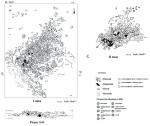Summary (English)
EXPLORATIONS NEAR THE VILLAGE OF CHUKOVEZER (Borislav Borislavov – b_borislavov@hotmail.com) Late Antique and Late Bronze Age structures were documented in 2014. Five inhumation burials were explored in 2015. The dead in Grave No. 2 was a woman over 30 years old, rested in a Hocker position on her right side and oriented west – east. Forty-three small gold rings of the Early Bronze Age III were discovered on her neck. The bodies in the rest inhumation burials were laid supine, oriented north – south and the burial pits were covered with roughly-cut stones. The dead were three men (one 18 – 20 years old and two 16 – 18 years old), a woman over 20 years old and a child 8 – 10 years old. The grave goods included two small bronze knives, ceramic cups and a spindle whorl. Remains from funerary feasts, each one containing one or two ceramic vessels were documented at 30 – 40 cm from two of the burial pits. The four graves dated to the end of the Late Bronze Age (end of the 12th – beginning of the 11th centuries BC). A burial structure of the beginning of the Early Iron Age (middle of the 11th – beginning of the 10th centuries BC) was discovered, containing five urns (three amphora-like vessels, a pot and a kantharos) with cremated bones. The urns were placed in dug out into the bedrock and were grouped within two circles of stones, covered with one layer of stones. A building 10.90 m by 6 m in size was discovered. Its foundations were 50 cm wide, built in rubble masonry. The finds included iron tools, a coin, a silver fibula, bronze jewelry and a bronze amulet showing a human head with Negroid features. The building dated to the second half of the 3rd century AD and was destroyed by fire. Debris from a ramshackle building of the middle of the 4th century AD was explored to the northeast. Debris from other buildings was documented as well and the finds included sherds, loom weights, a silver finger-ring, bronze fibulae, an earring, a lead plumb, an exagium and over 70 bronze coins of the 3rd – 5th centuries AD. A hoard containing 23 folles of AD 299 – 316 was discovered.
- Borislav Borislavov - Archaeological Institute with Museum
Director
Team
Research Body
- Archaeological Institute with Museum






![Download [PDF]](/excavation/skins/fasti/images/results/download_sml.png)
